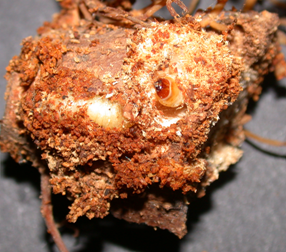
Vijai Pandian, UW-Extension Brown County and Phil Pellitteri, UW Insect Diagnostic Lab
Revised: 8/13/2012
Item number: XHT1183
Pine root collar weevil is a destructive pest of Austrian pine, Scots pine, red pine and more rarely Eastern white pine. Young Austrian, Scots and red pines that are two to four inches in diameter at the soil line can be killed by this pest. Only two to four pine root collar weevil larvae are needed to cause significant damage in an infested tree.
Appearance: Adult pine root collar weevils are dark brown to black in color with small whitish specks scattered on their bodies. They have characteristic stout beaks that curve downward. Adults vary in length from 9 mm to 12 mm. Larvae are creamy-white with a dark reddish brown head and are legless. They have strong mandibles (i.e., mouth parts) that help them chew bark. Full grown larvae are approximately 14 to 17 mm in length.
Symptoms and Effects: Pine root collar weevil larvae cause more damage to pine trees than adults. Larvae bore into the cambial region (just under the bark) and feed extensively on the inner bark at and near the root collar region (at or below where the trunk enters the soil). Girdling from this feeding causes a size reduction in the trunk beneath the soil line and makes trees vulnerable to tip-over during high winds. Also, girdling blocks the movement of nutrients and water to tree branches, gradually causing needles to turn yellow and brown. Another external sign of a pine root collar weevil larval infestation is the presence of blackened pitch in the root collar zone.
Adult pine root collar weevils cause small wounds on bark, branches and shoots, leading to dieback of the shoots.
Life Cycle: Pine root collar weevils complete their life cycle in two to three years. Adults emerge during mid-summer and early fall, and begin feeding on the bark of pine branches that are close to the ground. During the day, adults typically stay close to the base of the tree or hide underneath leaf litter. On warm nights, adult weevils feed on shoots in the crown of pine trees. During mid to late fall, adults begin hibernating beneath leaf litter, in bark crevices or in the soil near the trunks of pine trees. They emerge from hibernation in early May and start mating actively. Adult females lay eggs in the root collars of pines, or in the soil around pines just beneath the soil surface. Larvae emerge from eggs approximately two weeks after eggs have been laid, and begin to feed on below-ground bark and cambial tissue of pine root collars. Larvae pupate from late June through mid-August in the soil, or in tunnels in pine root collars.
Control: An integrated approach to control that includes cultural, physical and chemical practices can help prevent and minimize the spread of pine root collar weevils. Control practices should include the following.
• Avoid deep planting of pine trees. When planting pines, make sure that the root collar is just above the soil line.
• Prune off lower branches of pine trees to allow better light penetration and air circulation around the base of trees.
• Remove any competing weeds from around the trunk.
• Remove needle litter and other debris, as well as woodchip or sawdust mulch, in and around the base of pine trees.
• Drench the soil around the root collar region with an insecticide containing bifenthrin, permethrin, or acephate prior to mid-May to kill hibernating adult weevils and prevent them from laying eggs. A second drench should be applied in mid-August to kill newly hatched adults.
In areas where pine root collar weevils are common, avoid planting large stands of Austrian, Scots or red pine. White pine oftentimes can be grown with success in areas where pine root collar weevil is a problem as this type of pine is less susceptible to the insect.
Additional Images
Download Article

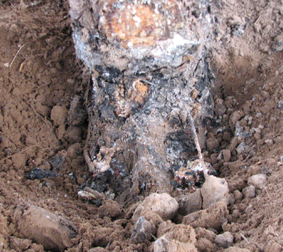




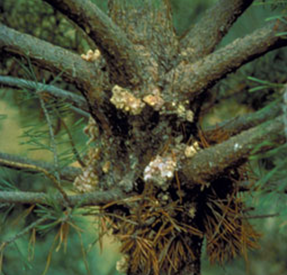 Zimmerman Pine Moth
Zimmerman Pine Moth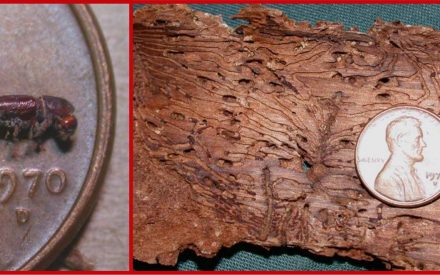 Ips Bark Beetle
Ips Bark Beetle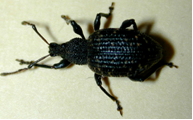 Degree Days for Common Landscape Insect Pests
Degree Days for Common Landscape Insect Pests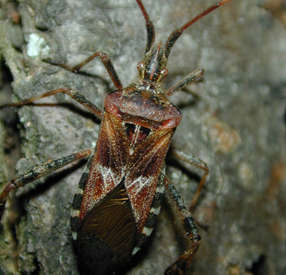 Western Conifer Seed Bug
Western Conifer Seed Bug


